I know lots of you have seen this photo before as I have used it as a signature image for some time. Unsurprisingly a number have asked, ‘There must be a story behind that stag, Steve. Tell us about it’. Well, here goes…You can no doubt tell by how much I have aged that it was a number of years ago. I was working my way up an overgrown, neglected river in East Gippsland making a trail, opening up some country that had pretty much closed over with regrowth and blackberries. (No, I am not going to tell you which one – go find your own river!)
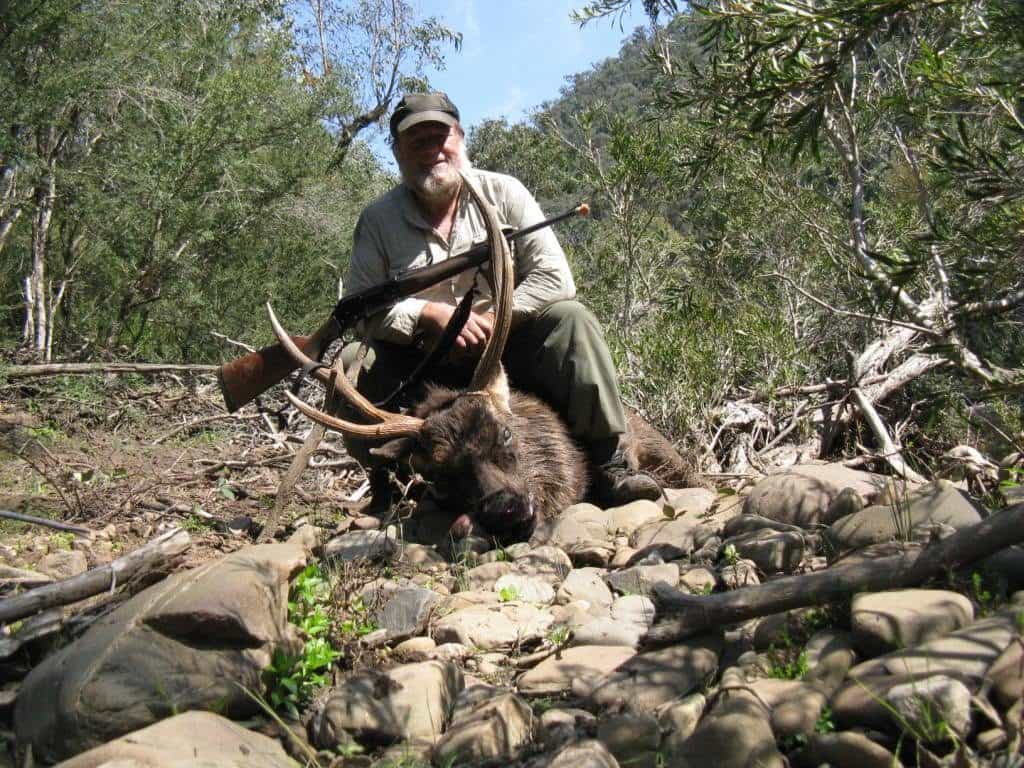
I live two hours from the city, yet I had had over four hours of comfortable driving in the old Land Rover Defender and then a couple more of rough 4WD scrambling to arrive at the end of the track where a relatively popular vehicle hunter’s camp was to be found. There would be no point in hunting anywhere within half a day’s walk of it if I wanted to see undisturbed deer. There was no-one there – one of the advantages of being a shift worker, farmer or retired is that you can hunt during the week when pretty much no-one else is about. It takes the deer a couple of days to settle down after they have been quite stirred up by the weekend warriors – even longer now that so many are wearing the dreadful camo clothing which is so impractical, unnecessary, even dangerous unless it is blaze orange, which looks just as silly though.
Other folk had pretty much pushed and broken a path up along the river through the predominantly black wattle regrowth to the intersection with another small river flowing in on the true right bank where most had turned off. I was enlarging this with my machete in case I wanted to bring my wife with me on a future expedition as she is partially sighted, so needing a pretty clear path to follow. I had this small river to cross on the first day and a number of side gullies. The little river looked promising, and was clearly where most people go to hunt, as their paths led that way – but I was heading up the main one.
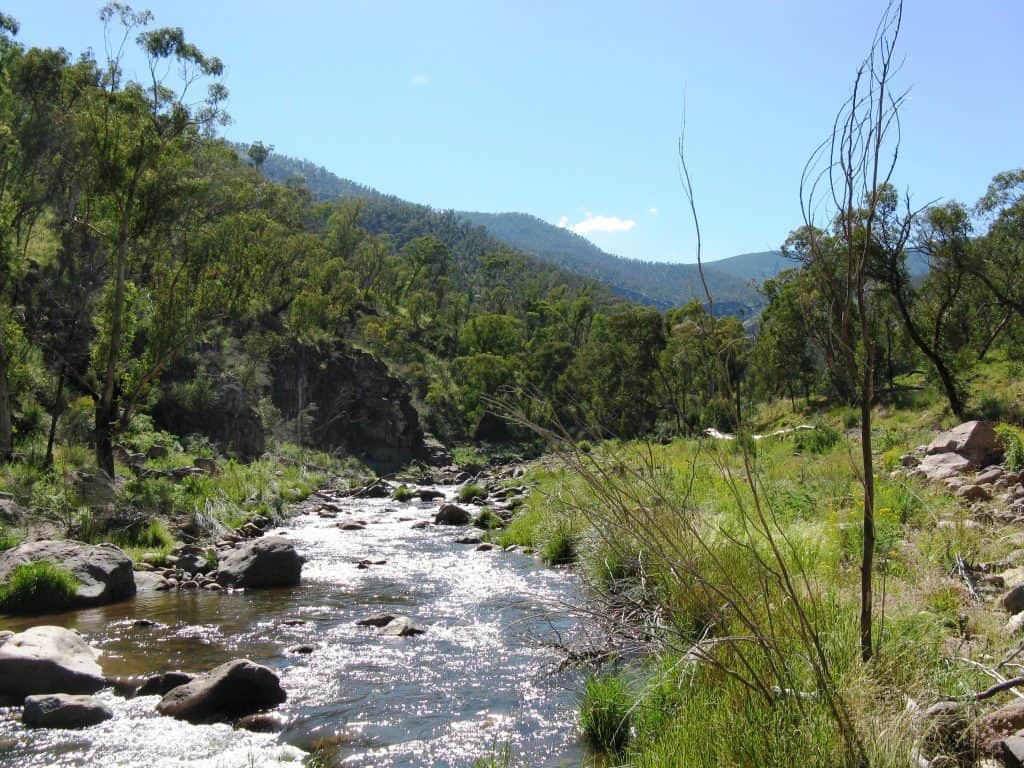
This is what the side river looked like a little further up after you had cleared the thicker stuff. Worth some exploration on another occasion perhaps, except that was where most folk were going. The lie of the land tells me there are some good flats up there somewhere, mostly where those big side gullies you can see come in. It is much more gentle country than where I was going. I have always preferred the harder country because of the lack of company you can enjoy there. ‘No company is better than bad company,’ I always say. And there are so many good books still to read – which are so light now that the e-book has been invented! I now read them on my phone which weighs just over a hundred grams and can also entertain me in other ways, even serve as a camera – and could even make a phone call if there was any signal where I go..
Those bluffs you can see mean you would have to cross and recross the river or climb deer paths over them. Of course, this is a very easy river to cross. (See: http://www.theultralighthiker.com/river-crossings/) Still, a lesson is in order: Can you see where you should cross this river? No, you don’t try boulder hopping eg top centre. Forget about having dry feet if you are hiking, fishing or deer hunting. You can make a pair of ultralight camp shoes so you will have dry feet of a night (such as these: http://www.theultralighthiker.com/19-gram-dyneema-camp-shoes/); that is all you need. Or a pair of Crocs if you aren’t handy.
Boulder hopping or log walking will just get you a nasty fall sometime far from help, perhaps a broken leg or fractured skull, or even death if you get swept away under a log jam. You should cross where the current is least (not necessarily where it is shallowest – do not worry about getting your thermometer wet; it will still work – after it has thawed out and you are more in the mood!), and where the bottom is not rock, but sand and gravel so you don’t slip – so step between the two large boulders centre left and work your way across above the two small rocks centre. That is where the water is slowest and you can see soft bottom between the rocks. You should try to cross facing upriver or downriver to minimise being knocked off your feet by the current. I find upriver best.
A stout stick (or hiking poles) will provide you with a third or fourth leg to help with balance. Many people say you should hold the pole upstream, but I favour downstream. Always undo your chest and hip belt, no matter how small the crossing. It is a good habit which will one day save your life. If you are swept away with your pack cinched up, you are in dire trouble. If the current is clearly such that you will likely be swept off your feet, either don’t cross at all or find a very long straight section where you can paddle across using your inflated sleeping mat as a kick board with your pack tied on top. You may have to walk quite a ways up or down a river to find such a spot. I have sometimes spent most of a day about finding just such a suitable crossing point in swollen rivers. And I have camped out for the better part of a week, waiting. Hunger is nothing like as bad as death! So, don’t you be impatient with your life! You may not get another! Certainly you would be lucky to get another half so good as the one we have!
After the crossing there were a number of flats and bluffy ridges to cross, an interesting anabranch with numerous wallows, one containing a large stag which fled noisily and precipitously, his klaxon on full volume. It was a fine warm day in late autumn and I was walking into the westering sun so that the sun winked endless reflections off the rippling water. I do love the echoic roar of fast white water. There were numerous rapids but nothing above Grade 2 and there was plenty of water for a future packrafting trip, which I have subsequently made. Delightful. I wish I had had my Klymit pack raft with me on this occasion: http://www.theultralighthiker.com/klymit-packraft/ (but…’If wishes were fishes…’)
The autumn break had long since arrived, so there was feed aplenty in the bush, such that any game was like to be in good condition. The wombats and wallabies were fat enough you had nearly to kick them out of the way. The air was alive with the beat of bronze-wing pigeon’s wings, wood swallows’ curving flight, currawongs calling. Wrens and sitellas crept along every branch rattling the bark. The tree fern gullies rang with lyrebird song… Below, a honeyeater taking the sun:
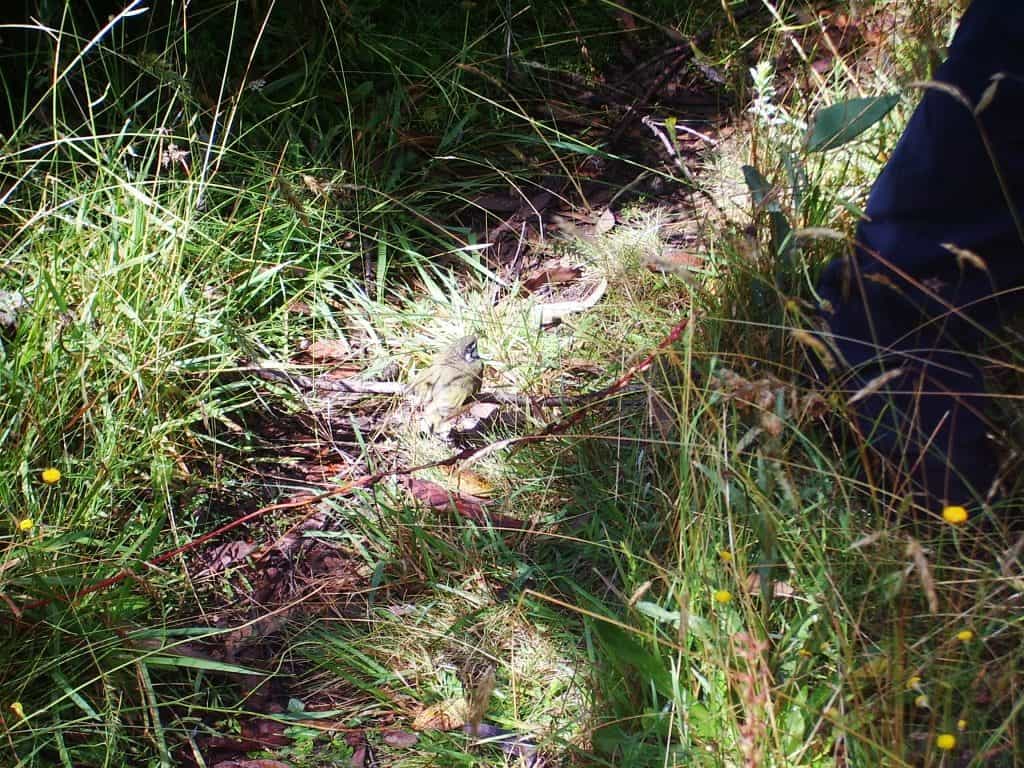
And above, a wood swallow, such a lambent grey:
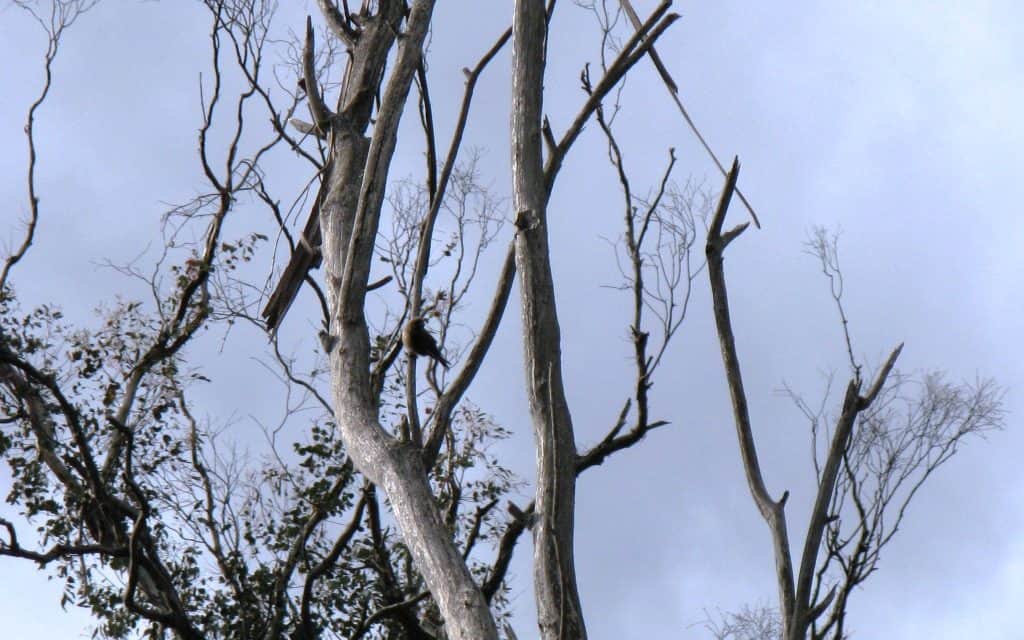
As you push along a river, you scatter the riverfolk before you. Time and again a blue crane croaks and rises awkwardly to claw his way pterodactyl-like upstream. Black and wood ducks scatter or loudly clap away around a bend. Every so often there is the soft dipping graceful flight of a blue jay, my favourite. And then I hear the whistle and click and I see the painted beauty of a bee-eater scything through the sky. Water dragons flop into the river; every so often a water rat glides off a wet bank otter-like. You can sometimes see the painted shards on the shingle where they have feasted on molluscs or small crustaceans.
This first trip here I only got about as far the first day as you could get in a half day if you were vehicle camping (way back there) and the track was already clear. I camped the night on the ground under my old home made 7′ by 7′ two ounce weight nylon tarp (below), as I was tired and there just weren’t any suitable trees in the only suitable spot close to water. This is sometimes the case with hammock camping, so you should be flexible enough that you can camp on the ground. See: http://www.theultralighthiker.com/hammock-hunting-till-dark/. This tarp cost me $7 a metre to make many years ago, so it cost less than $30 intoto , and I have had about a thousand dollars use out of it!
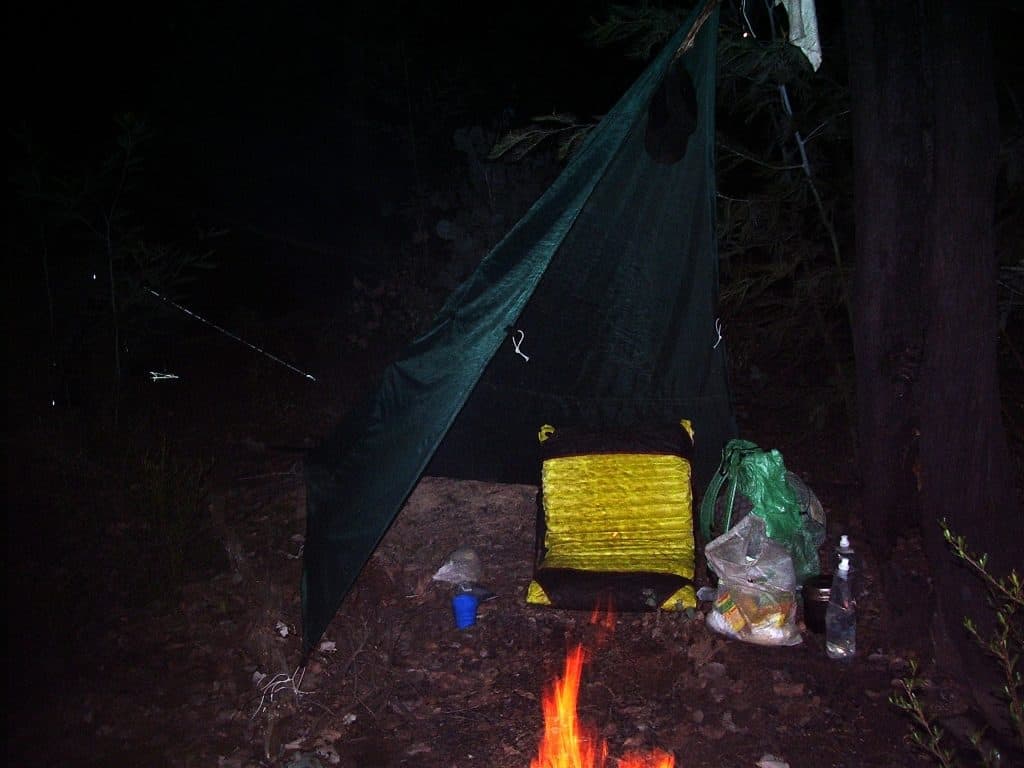
A tarp of these dimensions is pretty much the minimum for shelter for one person. For two you need something slightly bigger, such as my 8′ x 8′ ‘winged’ 200 gram cuben tarp I have mentioned many times. You can sleep sideways in it under the overhang and stay quite dry unless the weather circles the compass, in which case you will have to swing it round too – but that just about never happens. You worry too much!. You can have a nice cheery fire out the front, like this. You can instead use it as a hammock tarp and it will still keep you quite dry. In silnylon it would weigh about 220 grams. In cuben maybe a hundred. I am going to make up my poncho in this 7’x7′ configuration soon, as it will be even handier if it is your raincoat too: http://www.theultralighthiker.com/hole-less-ponchoshelter/. The waterproof zips now available are quite magical. See: http://www.theultralighthiker.com/the-pocket-poncho-tent/
I cooked my meal on the Bushbuddy stove (shown): http://www.theultralighthiker.com/bushbuddy-stove/, some Chinese sausage with mash and Surprise peas. A fair meal, but I have better. (Try a search above for ‘Food’)
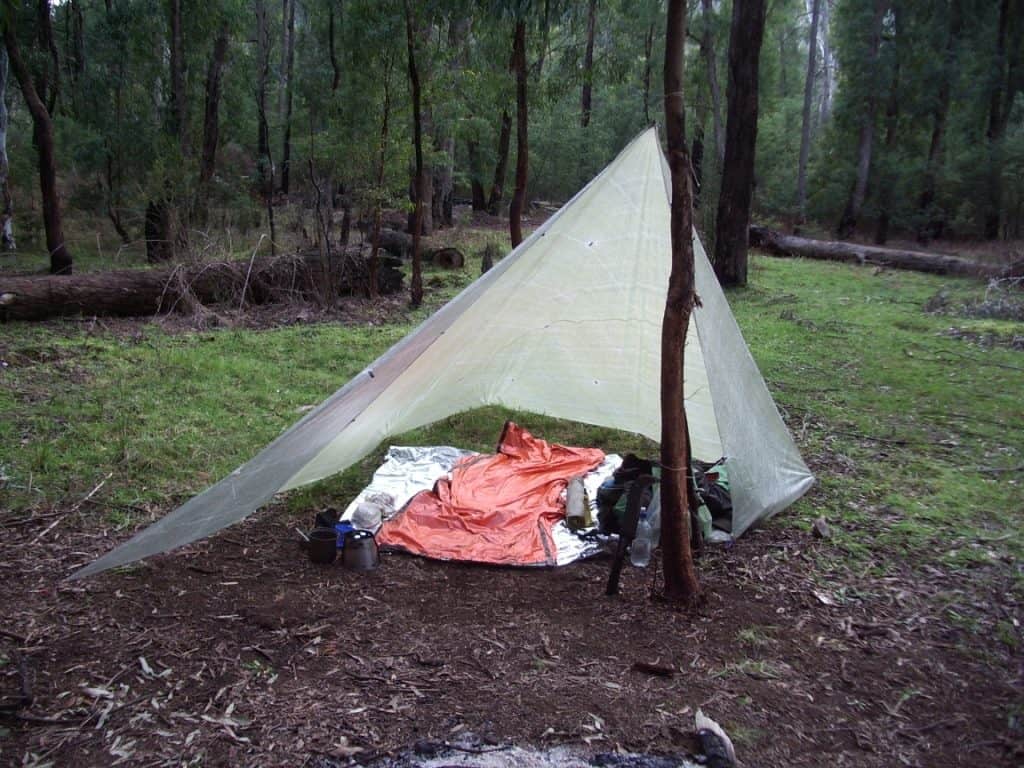
The cuben tarp with one ‘wing’ closed. You can see it again here: http://www.theultralighthiker.com/hammock-camping-double-bunking/
I can tell you are thinking I haven’t got enough gear for a few night’s camping in the bush when temperatures may fall to freezing. That (230 gram cuben fibre) pack looks just too small to contain a change of (warm) clothes, a raincoat, sleeping bag, food, etc. However, I can see that I even had enough space for a small quantity of Bacardi 151 rum in case the nights got just too cold! You take too much! And I could have used the tarp as a raincoat. By the time I was sitting down to tea in the tarp (as you see me) the temperature was already falling down to 5C or less, but I am still in my shirtsleeves. This is what having a warm open shelter with a fire out the front is all about! You really need one of those Big Agnes Cyclone chairs I have got (http://www.theultralighthiker.com/cyclone-chair/) and the Thermarest Neoair mat if you haven’t already got one to be really comfy. I see from the photo that this was before they came up with the women’s model (http://www.theultralighthiker.com/womens-are-great-in-bed/), or perhaps I took the one with the rectangular corners as it is more suitable for hammock camping. I have not bothered with a ground sheet as the ground was nice and dry after that warm sunny day. I had an emergency space blanket I could use ( 50 grams – as above) if it rained. If you want an idea of what I carry for a fair expedition, have a look at the list here: http://www.theultralighthiker.com/a-gorilla-in-the-hand/
I had stopped at this spot where a tree-choked blackberry gully entered the river because the way ahead was closed by bluffs on each side of the river and a hugely dense blackberry thicket. There were good numbers of deer up the side gully and a dozen or so came down just after dusk to serenade me as I cooked my supper. You could see their eyes winking like fireflies in the light of my head torch just outside the circle of the firelight. They usually vent their disapproval like busy traffic for five minutes or so, then move on about their own cervine business.
It looked too thick to hunt up the side gully though. Perhaps it opens up further up. On the map it is many kilometres long, and carries a lot of water in a wet season judging by the debris where it joins the river. This is sometimes the case. I still haven’t checked it out. There are many such stream bends to peer around whose surprises I may never see. The far horizon retreats just as quickly as your footsteps advance. And time waits for no man. It has waited quite a while for me already though!
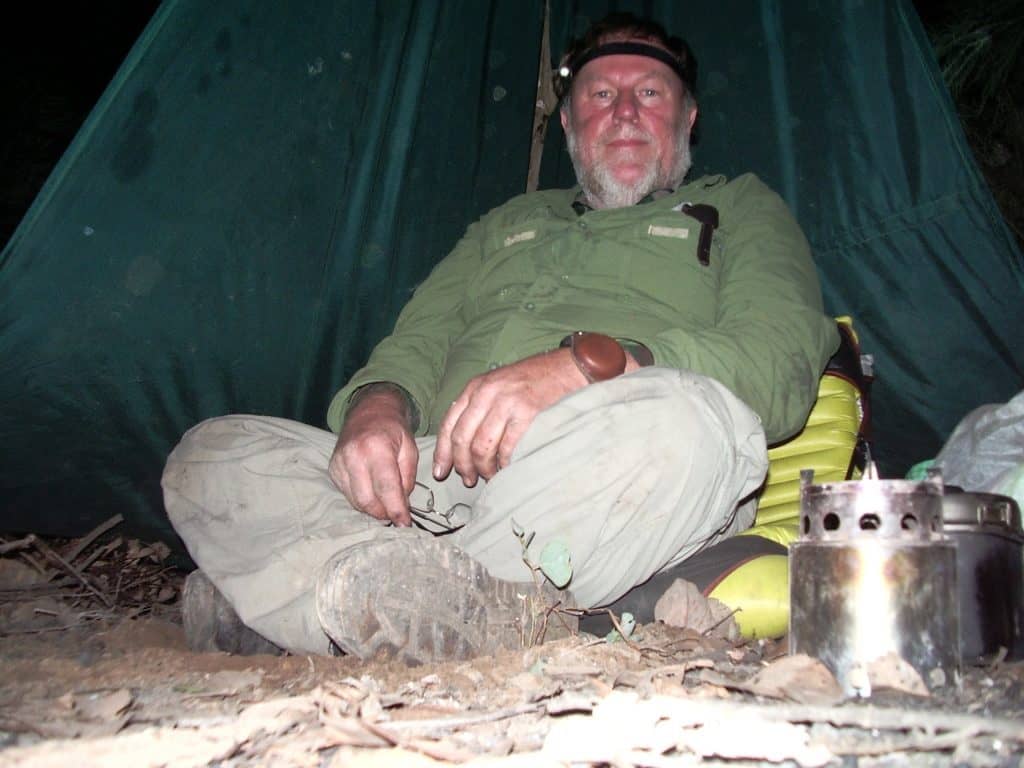
In the morning I put off work long enough to snag a trout for my breakfast on a hand line (See: http://www.theultralighthiker.com/the-ultralight-fisherman/) Alfoil grilled trout with muesli might not be everyone’s view of ambrosia, but I felt they were pretty good. These East Gippsland rivers are alive with trout. You should always bring a line. Bait is easy: trout will eat anything. When I went to wash the dishes I noticed signs of an old hand’s camp I had missed the night before in much the same spot from years’ ago. The remains of a rusted hurricane lamp hung from a nail driven into a tree branch, and there was an old handle-less frypan scattered amid the tussocks. I bet they had heard a tale or two in times gone by.
The next day I had nearly 200 metres of blackberry regrowth to hack a tunnel through almost straightaway. In places it was 12′ high and thick as your wrist, so it was hard going., and as a result I did not get very far the second day. Not even a deer had penetrated this thicket. It was a narrow gorgy section both sides of the river at this point so it was clear no-one had penetrated further for some years either. Of course I was using this: http://www.theultralighthiker.com/the-worlds-greatest-machete/ You should get one(or two). Up to this point, the first day and a half’s hacking had seemed pretty unpromising. Sure, there were deer about. I had several honk at me and a few others crash away into the bush. One had even ploughed across the swollen river, unseen because of the thick regrowth, but you have to be able to actually see them if you are going to take one home.
The bush is sprinkled with scenes of great beauty, yet it can be improved: here a bower bird has scoured the bush to find blue coloured objects (as they do). No other colour stands out quite so well in our forests. He has made a pretty spot for himself underneath the blackberry and dogwood fronds and amongst the wild marshmallow. You hope his efforts were rewarded with a doting mate!
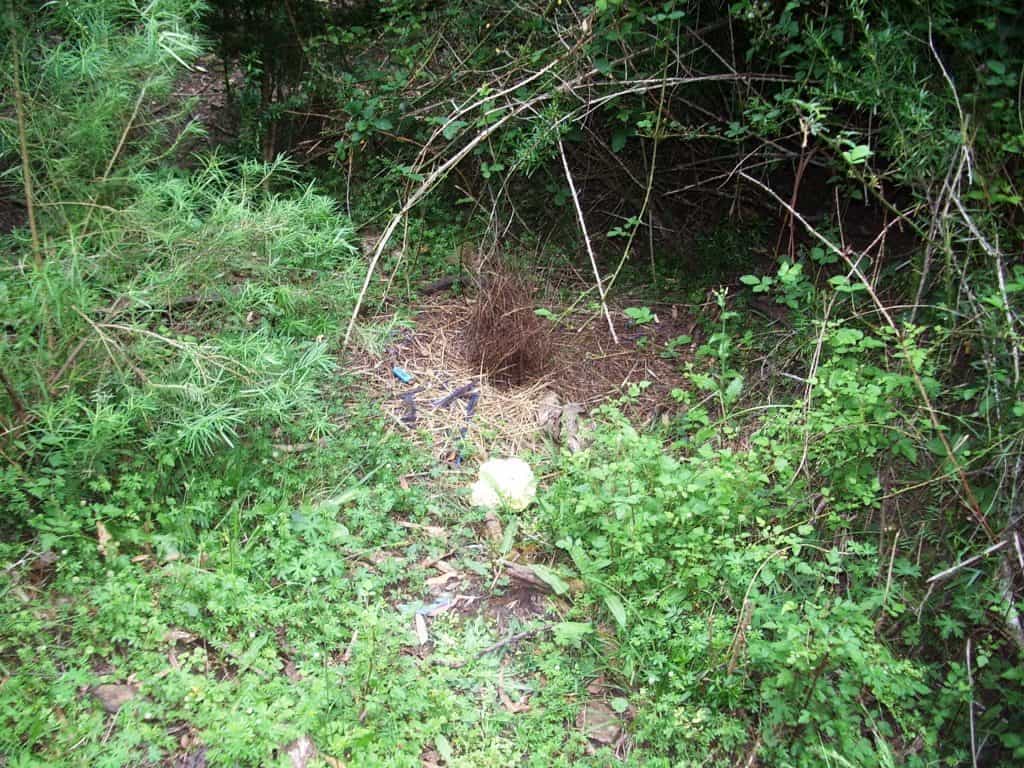
I guess other people had expected that the thick stuff would go on forever and had given up on this particular valley which is why I had it pretty much to myself. I was beginning to think so too, I must confess but once clear of this horror patch of blackberries the river flats on both sides started to open up a bit. Sometimes you could see a hundred yards through the trees, plenty enough to encourage me further on. Also, the deer I was beginning to see were now much less spooky. Instead of honking and crashing off, I was at least getting to see them for a bit. After lunch (http://www.theultralighthiker.com/lunch-on-the-trail/) I watched a doe with twin poddies (very unusual) for a few minutes before she grazed off around the corner of a side gully.
If you are watching deer, or any other animal never look them in the eye. Indeed, when they look at you, lower your gaze, or even bend double as if grazing. If you continue to ignore them in this way, they will usually ignore you too so long as you don’t move quickly. Just watch one of Attenborough’s documentaries how slowly a tiger for example stalks his prey even though he is always in broad daylight. You can stalk right up to a black wallaby, for example like this without spooking them. I have often demonstrated this to disbelievers, usually concluding the demonstration by snatching the startled hopper up by his tail, something which I do not recommend with a full size kangaroo – or a sambar deer! I have tried – both!
I love to watch the does gliding with their young, and the young gamboling like little lambs, running in circles, climbing and jumping from anthills, while the does move.ever.so.slowly – almost like wind-up deer, always with a front hoof poised quivering in the air, ready for a warning stomp telling the small flock: ‘Fly. Danger! And, in the wink of an eye they all disappear into the hushed silence of the bush.
Kookaburras delight in warning you that deer are moving just ahead: ‘Up this side gully. Quickly!’ Their raucous cries echo off the ridges. Of course they have their dawn and evening chorus. That’s not what I mean. How often have they alerted me to a big doe or stag just out of sight, but which I can then stalk. When I am chain-sawing firewood at home they will swoop between my face and the saw, their wings almost beating against my nose to snatch a grub or a wood roach my sawing has just revealed. Maybe they have feasted oft enough on venison, they are encouraging us onwards, ‘Feed me’ they call. Anyway, their daytime chorus ought not be ignored. I have followed their advice successfully many times.
As dusk swiftly approached the clearings on the other side of the river at this point were becoming a little more interesting, whereas I was walking along a narrow strip beside the river on mine, with just a thin string of spindly bushes along the river bank. I admit I was concentrating on the other side (though I had no intention of shooting something on the far side) as it seemed there was no cover to hide a deer on mine – only a bit of tussock and the low bushes. Yet suddenly this lovely stag stood right up from among the tussock, appearing as if from nowhere under the overhanging branches of a large bedraggled gum. There he stood glowing with robust health in his glory, framed by the westering sun and the succulent native willow. There was no skillful stalk or triumph of trick shooting in this encounter. It was just a second’s effort to throw my lever action up and send a bullet into his chest.
Somehow, no matter how many times you do this, you always expect that the loud report will drop them like a stone – and perhaps half the time this is so, but this guy just steamed off through the river like a locomotive. The water was shoulder high, yet he must have made a bow-wave three feet high as he clove the torrent. I drove another round into his chest as he crossed the river, but he showed no slackening. When he hit the other bank he turned 90 degrees and ran up it at a gallop, quickly disappearing from sight round a slight bend through the thick undergrowth. You always think, ‘Damn. Another miss’, but your confidence in your practiced skill tells you that both those rounds went soundly home, and this big guy has to be lying dead just around the corner very soon.
It doesn’t pay to rush ahead to check though, as likely this will just spook him further if he has any puff left at all, making him just that much harder to find if he manages to run off further, maybe into an acre or two of thick man-ferns. If you give him a spell, he will stop to try and understand what all the noise was, but when he stops he will just lie down quietly and die. So, that’s how I found him, just around the corner: He had crashed through that thick stuff behind him, and as soon as he was free and clear he paused an instant, crumpled and was gone. I always feel a terrible sense of loss when I kill anything. I will probably just stop someday when the pain of spoiled beauty becomes too great. But it was not this day!
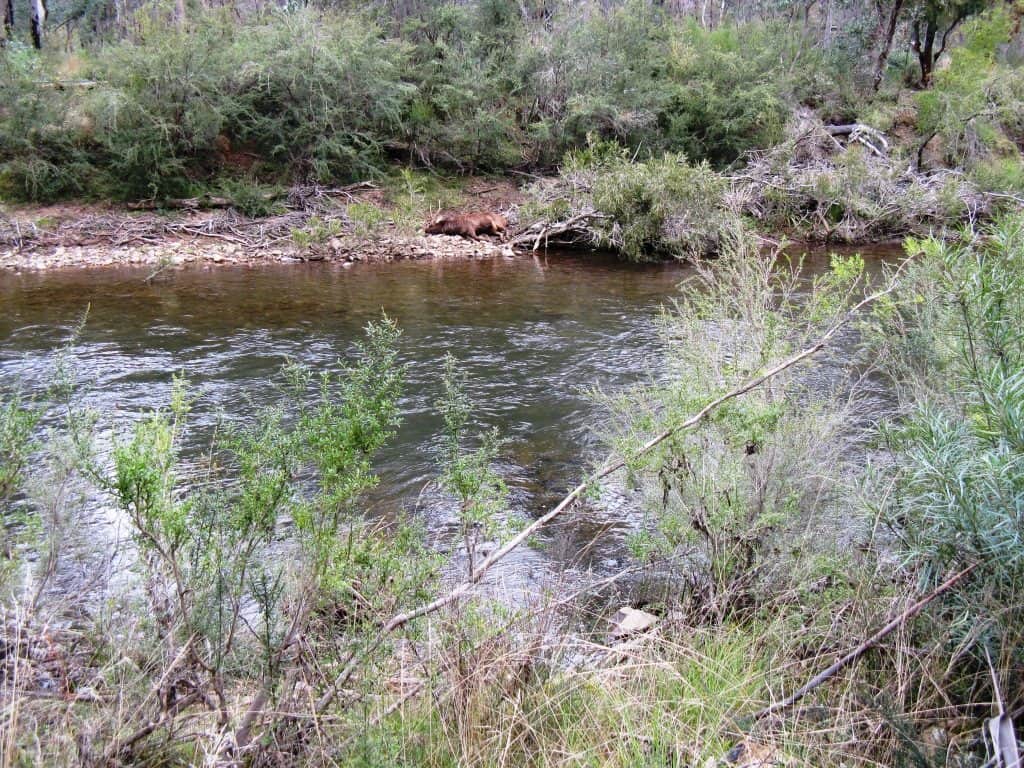
And there he lies, still. In the photo the river doesn’t look all that deep,or the current very great, but it is and it was. It was getting along at quite a fast walking pace here, so would have bowled me over like a straw man had I tried to cross, and swept me over rapids and what I would describe as ‘an entertaining drop’ if I was white water canoeing! And of course the water was icy. I had also seen nowhere I could have crossed safely either the previous day or this. And there was only a little over an hour of daylight left, as there usually is.
I headed upriver, hoping for a crossing, but I soon concluded I would have to camp and find a way across on the next day. I found a couple of suitable saplings to swing my hammock right next to a splendid sandy beach on the riverbank. Here it is in the morning light. Nothing better than this on the Riviera! You can probably figure I had a tranquil relaxed sleep wrapped in my hammock camped in such an idyllic place (and I did, except for troubled thoughts about having lost my trophy to the river – and time). As you can see, the weather was quite warm, and by now the stag had been lying out on the river shingle amid the native willows for 12 hours. I would need to find a safe way across the river very quickly if I was to recover anything.
If you have not tried hammock camping, you should. I was using a homemade hammock back then made of the same 2 oz stuff (coated ripstop nylon) as the tarp. It weighed around 350 grams including the dyneema suspension ‘ropes’. I am currently trialing one of these: http://www.theultralighthiker.com/a-hummingbird-in-the-hand/ which weighs less than 150. They are truly splendid hammocks.
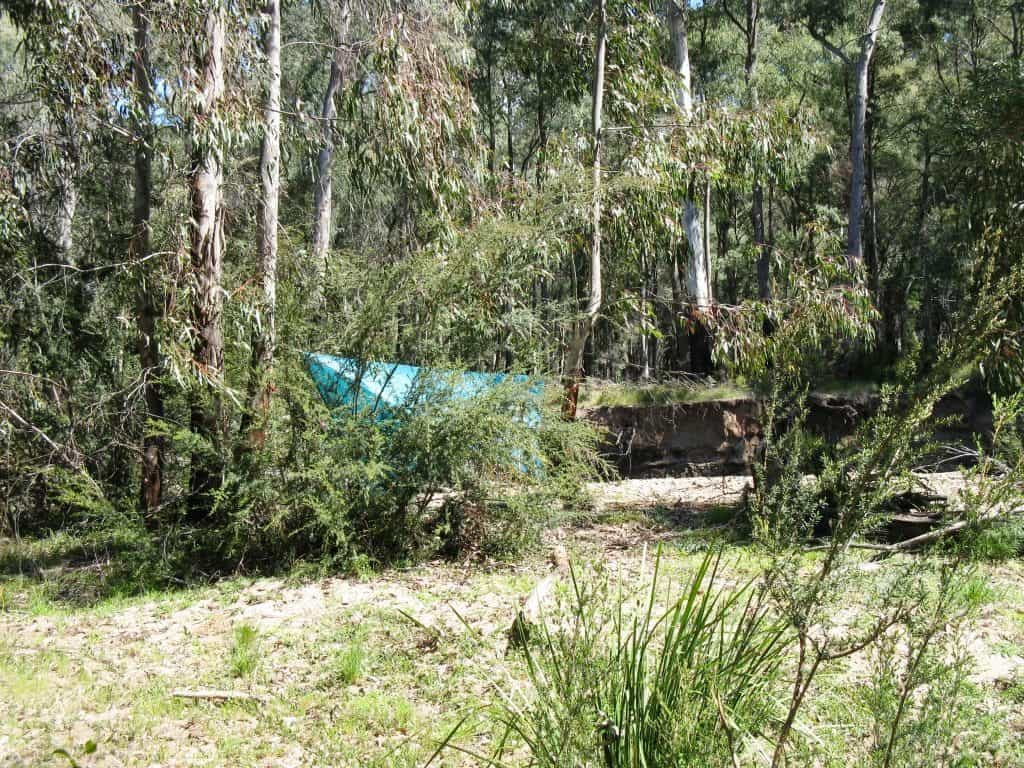
Here is a snap of me taking the sun in one on the shores of Dusky Sound Fiordland last month (April, 2017) while I watched some miniature (Hector’s) dolphins playing and frolicking in the limpid waters of the fiord. If you have not yet been there, put it on your ‘bucket list’. See: http://www.theultralighthiker.com/from-dawn-to-dusky/ BTW: I have now realised that I just missed a moose in the Hauroko Burn on my second day out. A photo would have been rewarded by a $100,000 prize, but would have been worth far more in achievement and memory than any money. Whether I will live to have another such opportunity, who can tell? Never ignore your sense of smell! – see Dusky 2.
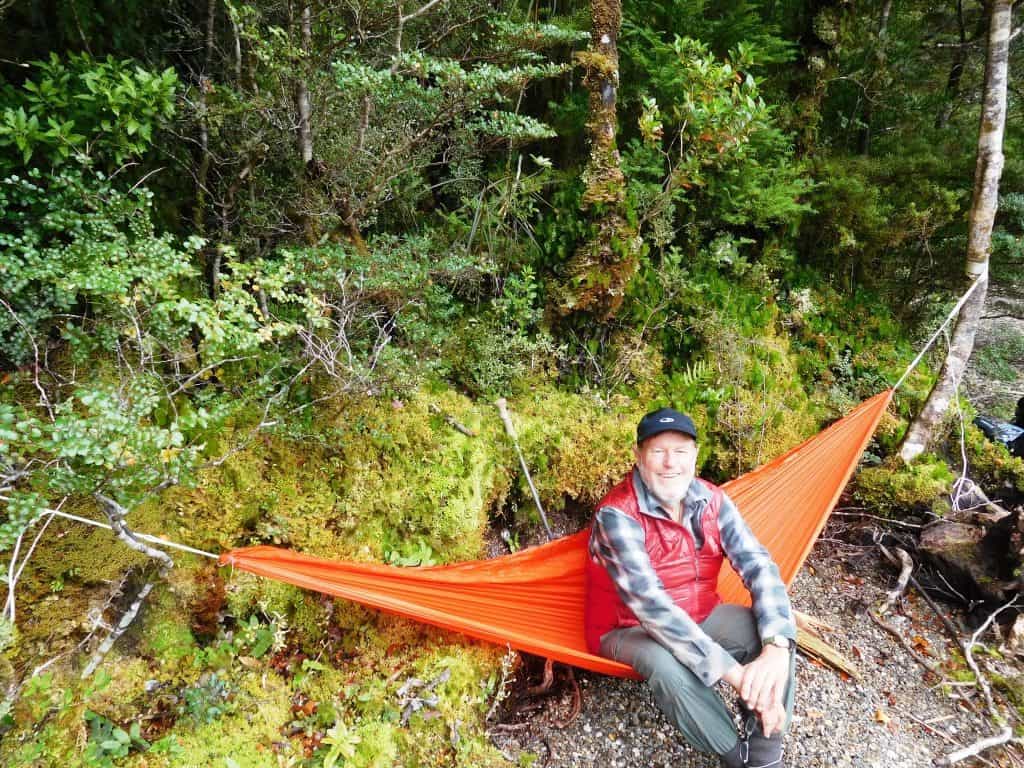
The moving light-play over the embers in the fire, the soft roar of the river, the mournful note of the mopoke and the moonlight creeping low over the frosty mountains are better than any entertainment on TV. What need is there of other company? You can safely give your heart to the mountains, knowing you will need no other friend. The awesome stillness of solitude is all the balm the troubled soul hearkens for. You can still fairly feel the warmth glowing out at you from the coals of my modest campfire. It was a colder night than my first and quickly fell to freezing, yet I was warm, sheltered in my hammock by the tarp, listening to some pleasant music and enjoying a quiet tipple of rum, some macadamias, beef jerky – and a hearty trail soup, such as this: http://www.theultralighthiker.com/ultralight-coconut-fish-curry/
I always sleep on my back in the hammock (insulated by my Neoair sleeping mat and a couple of small pieces of closed cell foam for my elbows. I have a small pillow which I put under my knees, not under my head; this is necessary: http://www.theultralighthiker.com/exped-ultralight-pillow/. It is more comfortable than any bed. There are no lumps or sticks to poke at you, and no creepy-crawlies running over your face as sometimes happens on the ground. A gentle, rhythmic sway quickly eases you to sleep, and you wake free of aches and pains which hard ground sometimes brings. There is also no danger your bed will get inundated if it rains in torrents, and you don’t need a flat spot. There is also no danger of being struck by lightning!
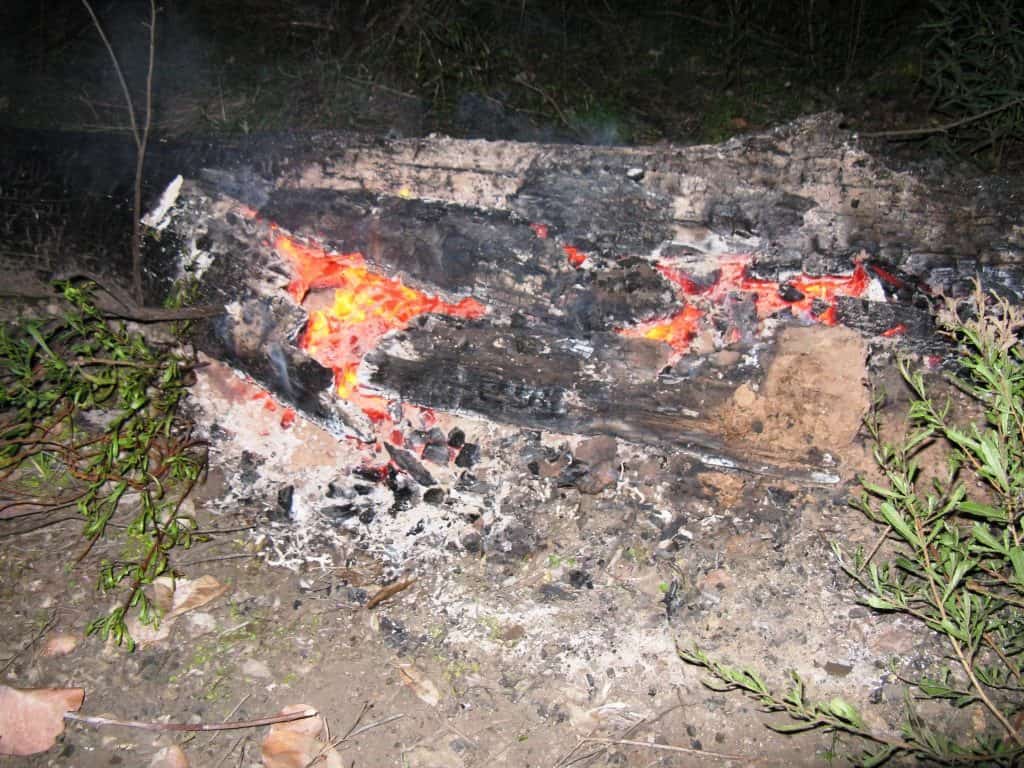
I was moving in the dawn after a breakfast just of muesli chased down with a cup of black coffee next morning. Not long afterwards I tripped over this heavy hunting stand in the long tussocks. It had clearly lain there these twenty years or more. What an incredible thing to have lugged so far through the wild bush! The placid bend where I had camped had it seems many times before been the camp of others – as it will doubtless be in future when I too am dust. In Fiordland, moose hunting I had tripped over a barbed wire fence deep in the near impenetrable jungle. There are few places others have not trod before, yet it is the feeling of solitude, of being the first, of being quite alone in the wilderness which leads us back again and again to push on and explore the wild places by ourselves.
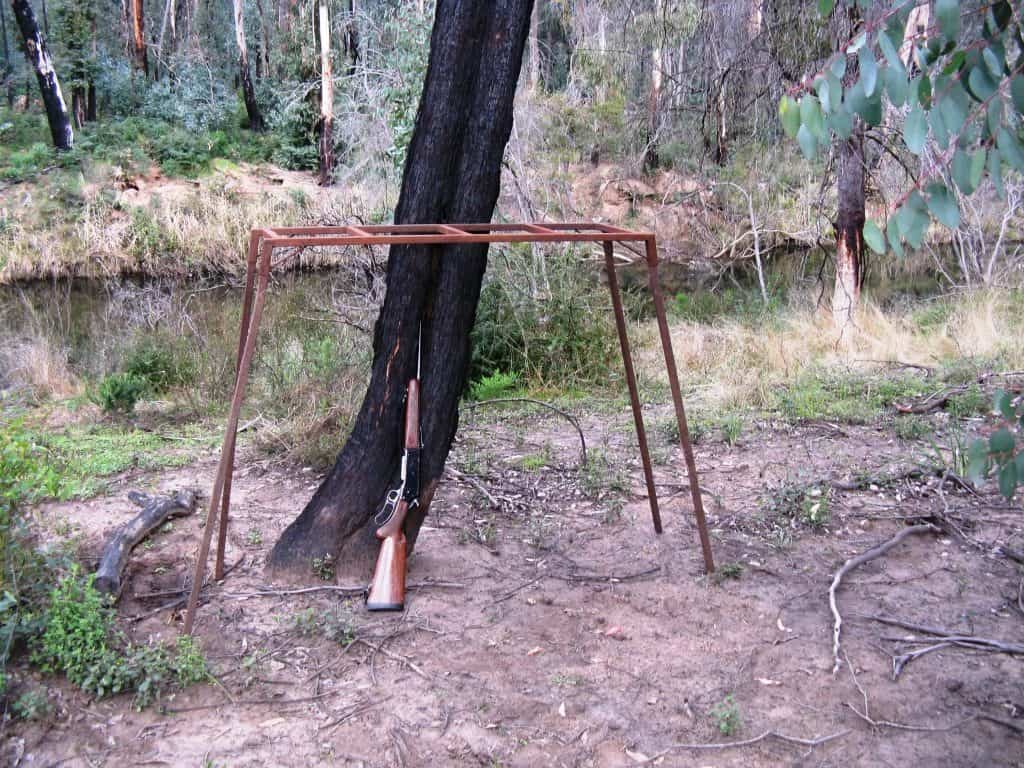
There were plenty of other deer about in the dawn, as indeed there had been in the gathering dusk the night before. I had watched a pair of does with their young frolicking and grazing not 200 yards from where I had shot the stag, and not half an hour afterwards! This is quite normal in undisturbed country. I passed a much better stag busy in a wallow right out in the open on the river margin next morning, again something you frequently see in undisturbed habitat, but not so much elsewhere. I had pretty much walked right by him (no more than twenty metres away) before he deigned to abandon his joyful smelly excesses, let forth a desultory bugle at me and rush off into the whippy undergrowth. Soon I discovered a truly beautiful flat, and clearly an old route once ‘properly’ blazed. Look at that feed! Note also the coprosma have been stripped of berries, yet it is fruit time! A promising sign. Deer do love mast.
Many wild fruits are edible (some even palatable). Both prickly and sweet coprosma are quite pleasant. Also lillypilly, pittosporum and wild cherry. (I doubt deer get many wild cherry as they usually browse it as high as they can reach – if you are ever in Fiordland ‘moose hunting’ as I am fond of doing, you will notice the browse line is nearly 3′ higher. Those guys really are monsters!). Contrary to popular belief plants which ooze white sap are not universally poisonous (though the sap may be) . Figs are a case in point, though there are not many wild figs in Victoria, save in far East Gippsland. Similarly the belief that red fruits should not be eaten is completely wrong, as the majority of fruits are red (especially the edible ones!) The clear to yellowish sap especially of wattles is quite edible and nutritious. We used to often eat it as children. Pretty much all fish, crustaceans and molluscs found in Victoria are not only edible, but delicious. So too are pretty much any animal or insect you will find if you roll over a log or stone, though a little roasting improves their taste I find. The heart of tree ferns is pure carbohydrate and has kept many folks well filed for protracted periods in the bush. It is better baked. All the rushes and sedges, including cumbungi have edible tubers, also best baked. There is no need to go hungry if you happen to find yourself lost in the bush. Nor need you be wet or cold. I will do some posts about such matters soon. Meanwhile, it is always worth practicing such survival skills as you never know when you will need them, and it boosts your self-confidence – particularly if, like me you prefer to hunt alone.
These fruits are fine (providing you have correctly identified them), but if you are tempted to try an unfamiliar fruit, you should first split it and touch the damp flesh to your lip, then wait five minutes. If nothing untoward happens, then touch it to your tongue and wait again. Next chew it a couple of times, then spit it out. If nothing at all has happened it is almost certainly fine to eat, though some things can make you scour especially in large doses. Interestingly enough, we know a lot about the edibility of many Australian plants from the likes of Sir Joseph Banks who was always keen to try eating new things. Again, the colony nearly starved a number of times (particularly 1791), so lots of plants were tried perforce, sea purslane and pigface for example. Europeans rapidly discovered just about as many edible plants in a decade as the previous inhabitants had in a much longer time. The latter were masters though at extracting poisons from otherwise inedible things, like cycads. Don’t even try.
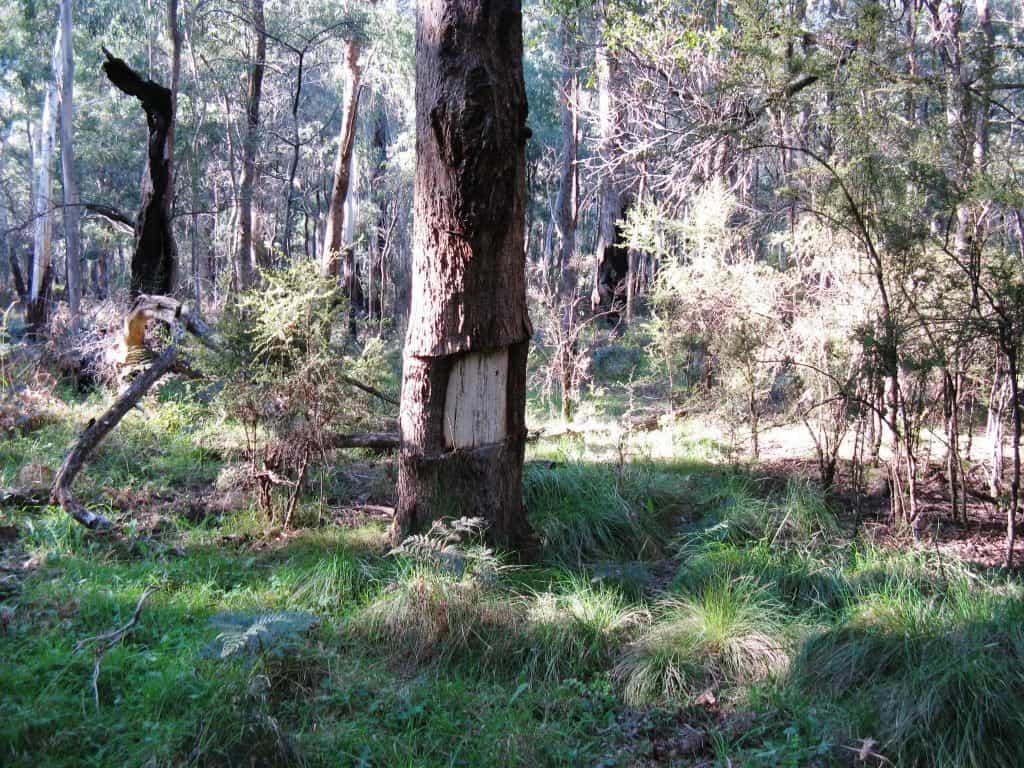
As the morning wore on, the river continued deep and swift with nothing in the way of a single safe crossing. The flats on the other side were truly beautiful though. Like a manicured park sprinkled with ash and peppermint gums. They would make good hunting once I discovered the fords the deer used. Fords are one of the best spots to lie in wait for them actually (if you are an ambush predator, which I am not; I get bored waiting, ever eager for new sights and sounds, and not much worried whether I ever take another deer). You can use the westering sun as a kind of spotlight to get a clear shot at the deer as they tiptoe across. This way you can (legally) take them quite close to dark. You need to position yourself though so that your shot will impact a river bank upstream and not skate along the river perhaps endangering someone else kilometres away. And, ideally you need to have already established a campsite quite close by. At least there will be plenty of water for your billy. There is also plenty of fallen timber for your campfire opposite. You could camp there for a year without using it all up, by the looks. Notice the animal drinking spot, centre. That would be a great side gully beyond. I bet there are many adventures to be had there.
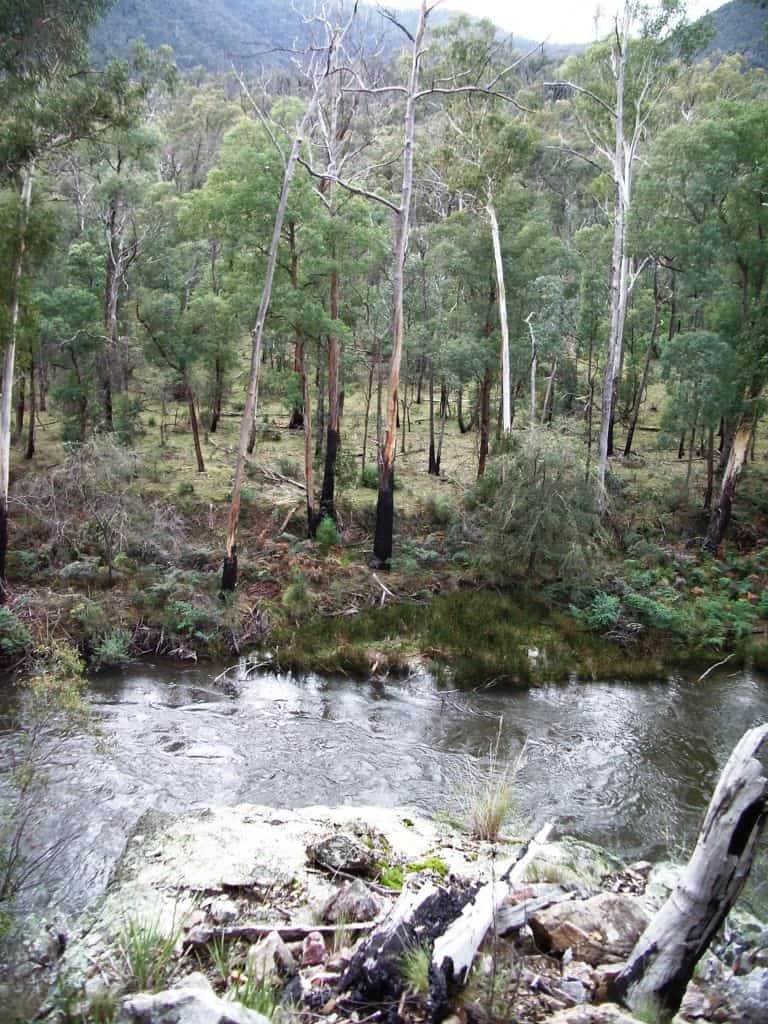
Look at this beautiful wallow I found. You can see how the stag has been using the trunks of the trees as his towel. They are well coated with malodourous mud. Here would be a good spot to search for a cast antler, or to wait for him to return as dusk or dawn. You should drag a branch through the bottom if you want to find one,as they are usually found rolled into it. If you find one it will give you a good indication of the size of the resident stag.
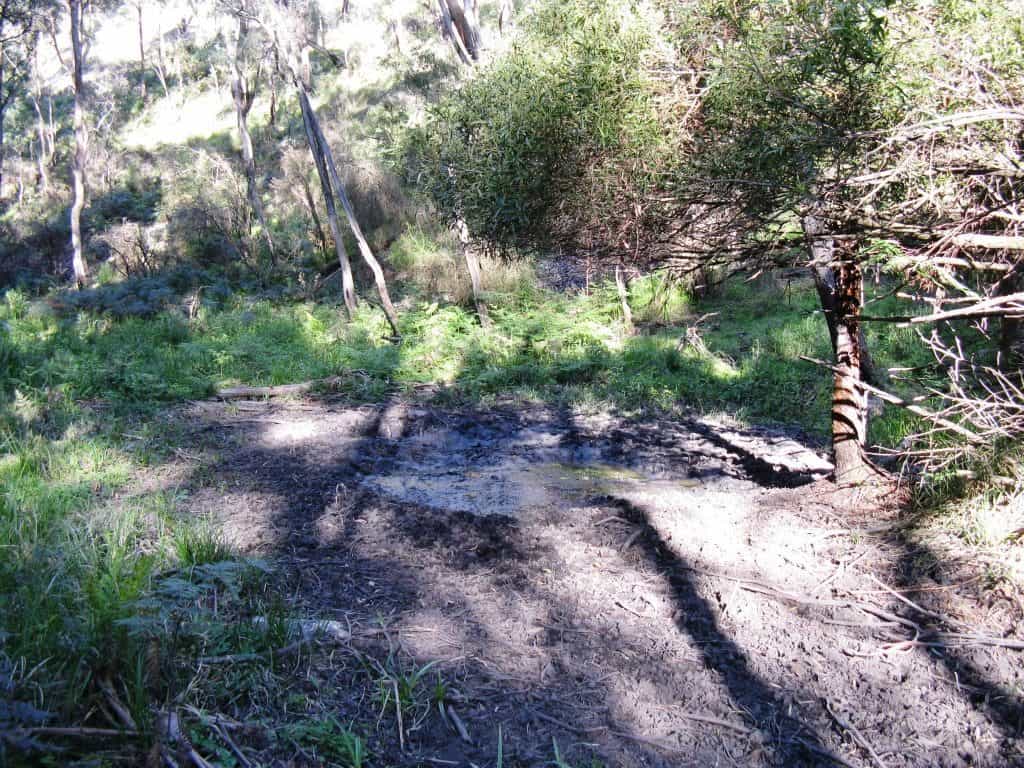
Finally I found just such a crossing: the water is slower and shallower here, but still waist deep. You can just make out a deer path on the opposite bank. The bracken flats opposite would make a sheltered ‘nursery’ area. It had taken nearly half a day to find a suitable crossing. I still needed a stout branch as a prop to prevent myself from being toppled over. I took another three hours to walk back to ‘my’ stag by which time I was long dry. Unfortunately he had now been lying there for a full twenty-four hours, all day in quite hot sun. His skin would ‘slip’ and I could not trust the meat would not have begun to spoil since he had not even been gutted. A sad waste really.
I deeply regretted my precipitate action in shooting him in the first place now. So often it is just much better to admire and wonder. I have done so many times since. Deer hunting is mostly an excuse for me to get out hiking and camping (sometimes into places you otherwise could not go, such as our ‘National Parks’ which are being saved for future generations, rather than ourselves).
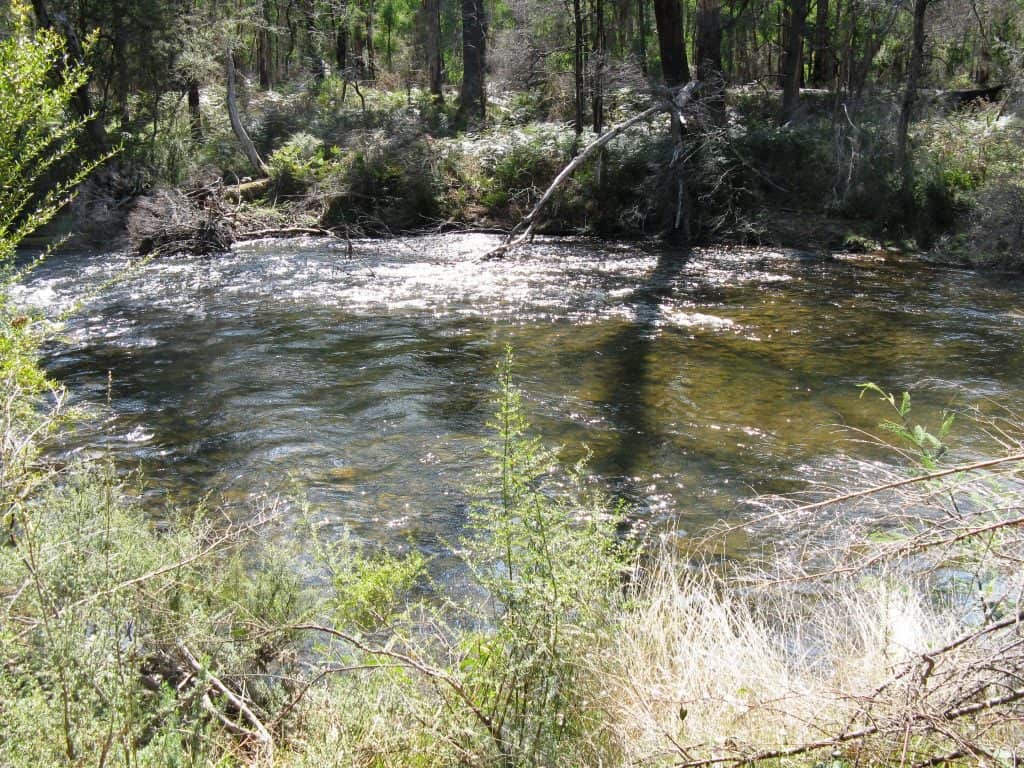
And here he is, lying as he fell (with my gun tangled in his rack!) I know the river looks as if you might cross there, but I can assure you I would have been swept away – and there were some particularly nasty rapids downstream. You just can’t take such a chance particularly when you are all alone in the wilderness. He was, as you can see, as fat as mud!
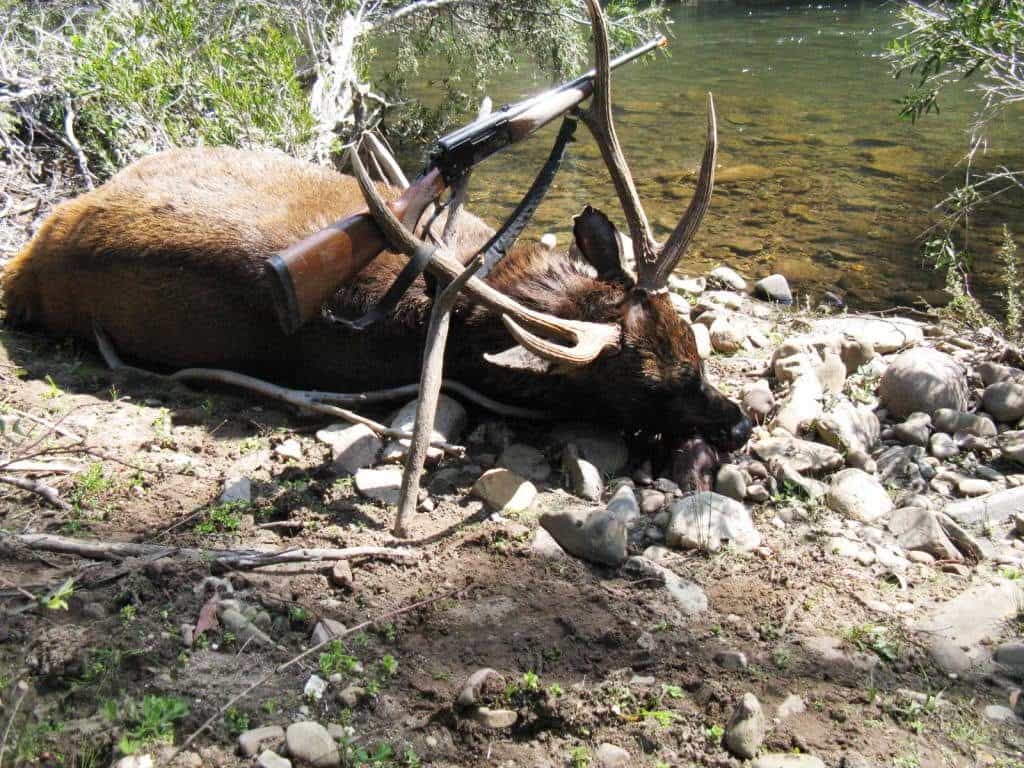
On another trip I found these (two) beautiful crossing points a further hour’s walk up the river. If only they had been a bit closer to where the stag had fallen, I could have had his meat and cape in the cold water of the river overnight, and back to my car before mid-day the next day if I had hurried – or if I had had my pack raft with me. Life is replete with ‘what-ifs’. You just can’t let them trouble you. The dice falls as it falls. That is all. You should have ‘no regrets’, as Edith Piaf said so mellifluously. We are just passing quietly through life. We arrive with nothing, and leave with nothing. Hopefully, you accumulate a few special memories along the way, such as the photo below, taken by my lovely wife Della on my next trip.
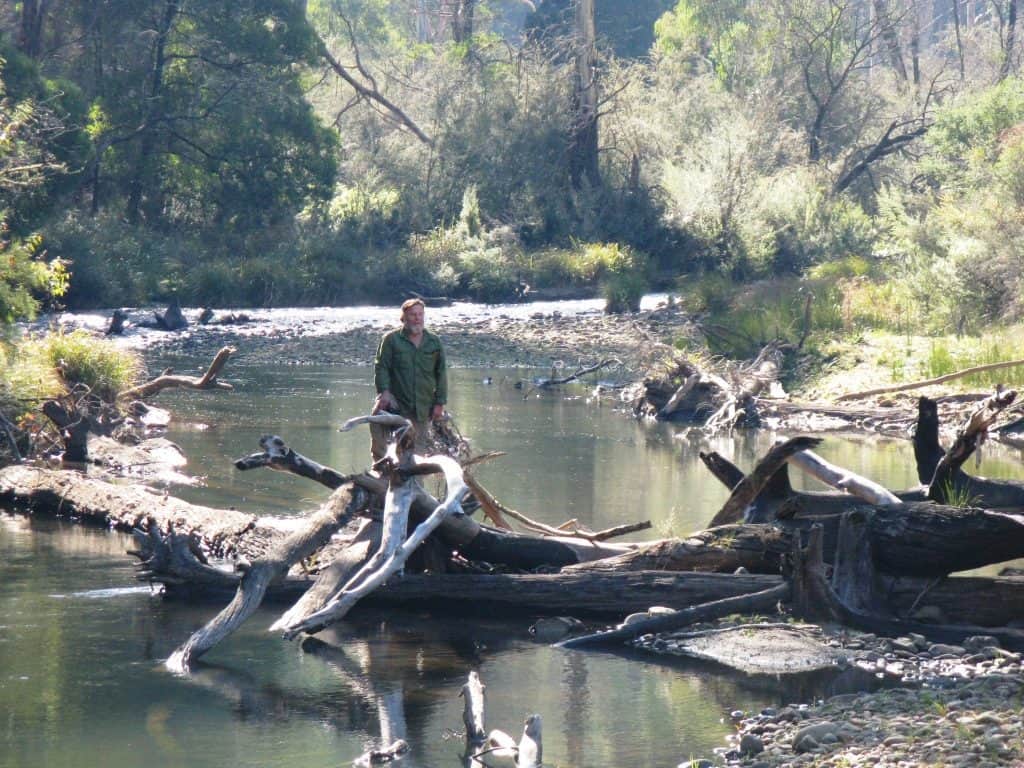
And mine of her: There she is, taking her ease on the riverbank opposite me. While we were camping there, a platypus swam around and around this huge pool for half an hour i guess. Such an enchanting sight.
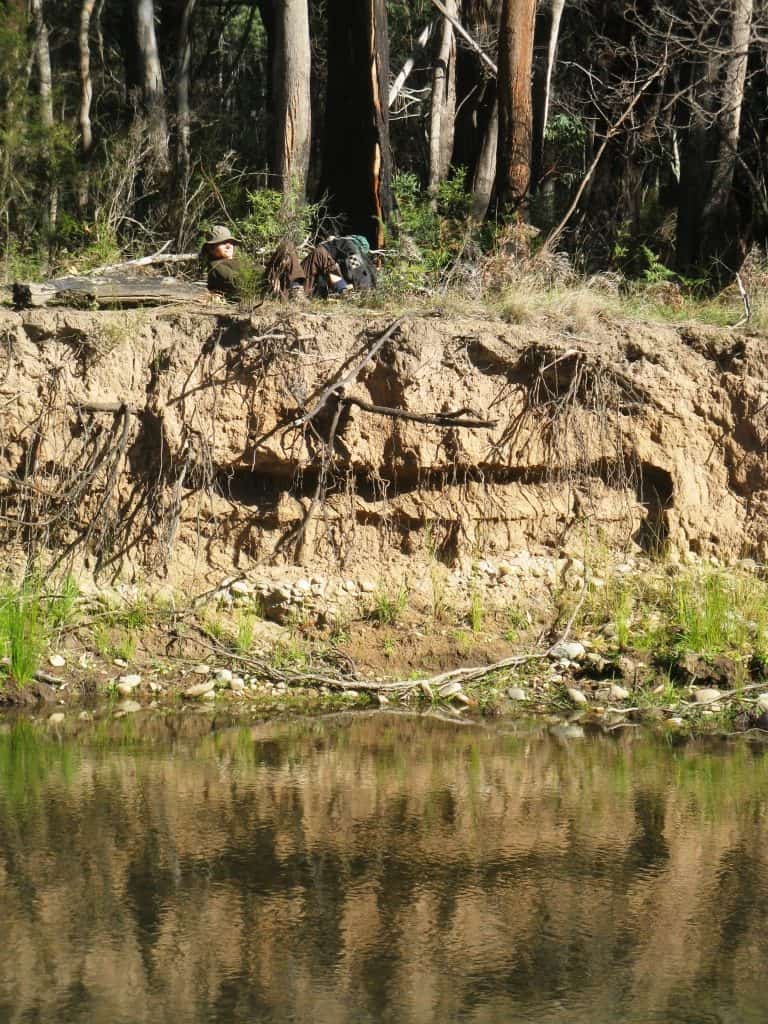
On an even later trip, the river came down in an awesome torrent, and did this whilst I was there. This was just around the corner from the photo above. I just had to wait it out. It pays to have a cache of food in a canoe drum (or similar) against such eventualities; anyway to have enough spare tucker. Tie it under a log well out of reach of any potential floodwaters, so the wombats and possums don’t p[lay games with it! You can easily see you could be trapped by floodwaters for a week or more. Half the forest must have ended up at this spot. I know the roar and grinding of the river overnight and sounds like gunshots as vast logs snapped like kindling when this happened was ominous in the extreme
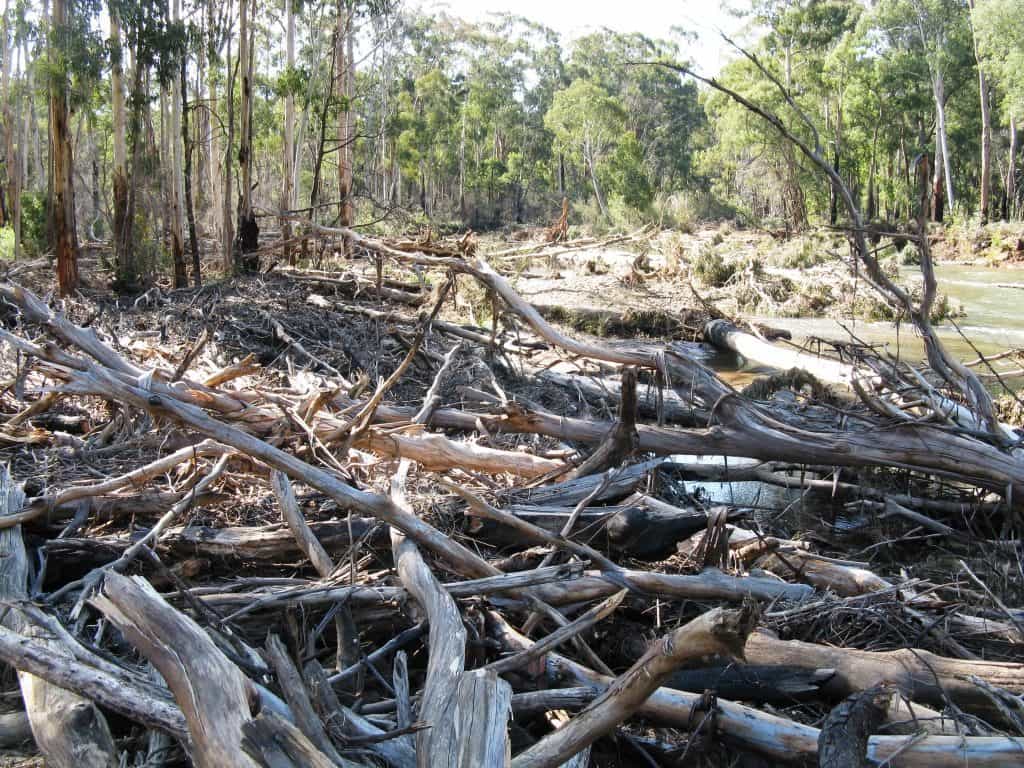
We have explored much further up the river since on a number of trips – and of course, now we can take the dogs. There are many splendors further up. We have gone five more days up. Still we are not to the end. I know most folks find one day’s walk away from their vehicle quite enough, mainly because they carry too much, but the further you go the more fascinating things you see. Always, the Victorian bush is a riot of wildflowers, even in winter when I most love to enjoy it. That’s why we have so many honeyeaters such that our State bird is one – I have even seen a little ‘helmeted’ guy here, though I never tell ‘the powers that be’ anything they don’t need to know! On this occasion every gully was bedecked with snowy clematis, and there were any number of parti-coloured wild peas in bloom.
We have found a truly splendid flat on a magnificent sweeping bend. It must be close to 100 hectares (as square kilometre) where we love to camp. the fishing and swimming is even good in summer. It resembles one of those beauteous English parks, the deer have done such a fine job manicuring it. Further on there is a wonderful hidden valley which you would just about step across without even noticing, but a day’s exploration up it will bring many delights: waterfalls, orchids, postcard-perfect clearings…Further on a second small river joins this one. It has a small plain a kilometre or so up which in the summer is a riot of everlasting daisies.
The best part is that when we want to head back to the car we can just blow up the packrafts and enjoy a delightful day or two (like Huck and Tom – or Ratty and Mole) just drifting and ‘mucking about’ on the river.
Of course this was not the end even of this trip. I was in no hurry to get back and had two days’ walk in any case, so I took my ease for a couple or three of delightful days lying about in my hammock in the sun, fishing, nosing up a side gully or two… Just in general really enjoying our beautiful Australian bush – and my solitude!
Alas, this is pretty much all I managed to recover from the stag. This was also just about the only time I have left meat in the bush. I had forgotten to pack my ’embryo wire’ or even a folding meat saw, so I had to take the antlers off one at a time (I could not even remove the skull cap whole). I only managed to do this by standing back a ways and putting a couple of shots into his skull so I could recover each antler with a shard of broken bone. Sometimes I am not so well organised either! Still, at least I have the antlers, arranged decoratively in a vase by Della as a reminder of a mountain adventure years ago. Hopefully, even at 68 there will yet be many more…
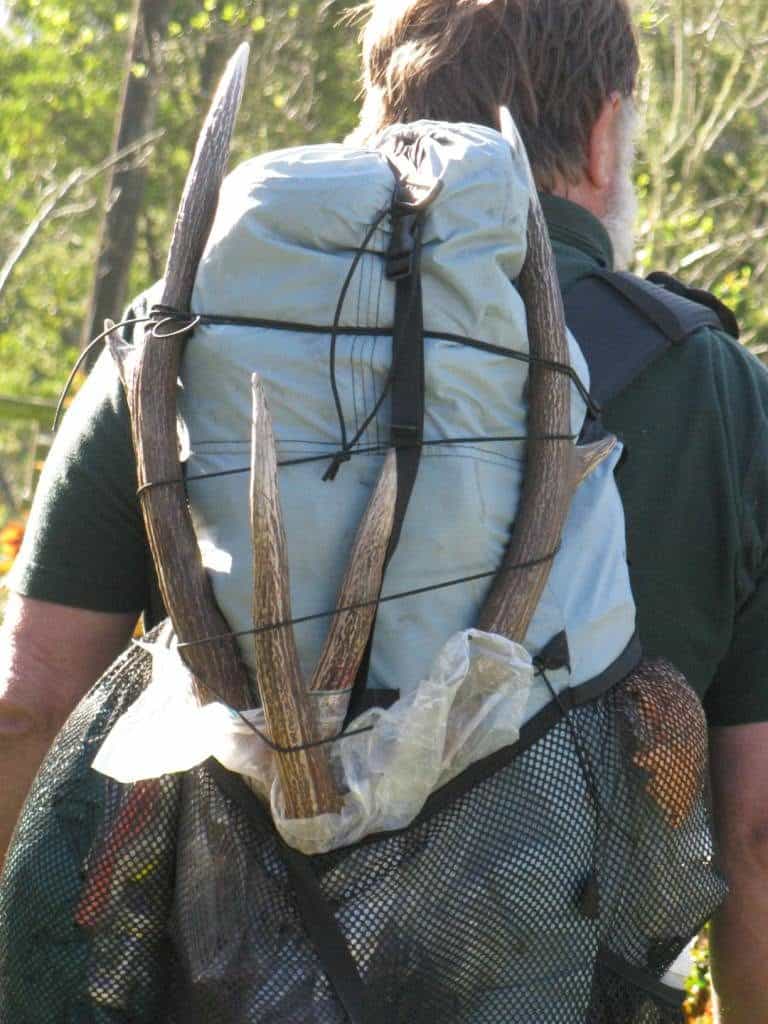
Unfortunately others have followed our trail, though most only travel one day upriver camping approximately where I crossed on this occasion, so that the deer thereabouts are much more skittish nowadays. Sometimes I venture a further five days upriver (as I said) where in winter there is never anyone about, and the deer are as common as rabbits!
PS: If you enjoyed this post, maybe you wouldn’t mind hitting the Facebook ‘Share’ button so some of your friends can enjoy it too! You might also want to ‘Like’ my page on Facebook: https://www.facebook.com/theultralighthiker/?ref=aymt_homepage_panel NB: There is a ‘Follow’ button below too, if you want to keep up with my doings here.
First Published on: May 29, 2017
Some Other Hunting Related Posts (there are many more):
Adventures:
http://www.theultralighthiker.com/a-gorilla-in-the-bush/
http://www.theultralighthiker.com/hammock-hunting-till-dark/
http://www.theultralighthiker.com/no-sew-sandals/
http://www.theultralighthiker.com/gippsland-pack-rafting-routes/
http://www.theultralighthiker.com/you-take-the-high-road-and-ill-take-the-low/
http://www.theultralighthiker.com/wonnangatta-waterford-to-angusvale-day-one/
http://www.theultralighthiker.com/sambar-stalking-101/
http://www.theultralighthiker.com/sambar-deer-stalking-102/
http://www.theultralighthiker.com/sambar-deer-stalking-103/
http://www.theultralighthiker.com/sambar-deer-stalking-104/
http://www.theultralighthiker.com/does-spot-like-to-hunt-deer/
http://www.theultralighthiker.com/spots-hunting-adventures-1-mystery-river/
http://www.theultralighthiker.com/spots-adventures-mystery-river-2/
http://www.theultralighthiker.com/spots-hunting-adventures-mystery-river-3/
http://www.theultralighthiker.com/not-quite-alone-in-the-wilderness/
http://www.theultralighthiker.com/hammock-hunting-till-dark/
http://www.theultralighthiker.com/you-take-the-high-road-and-ill-take-the-low/
http://www.theultralighthiker.com/hammock-camping-double-bunking/
http://www.theultralighthiker.com/backpacking-gear-advice/
http://www.theultralighthiker.com/dusky-track-adventures-1/
http://www.theultralighthiker.com/dusky-track-canoeing-the-seaforth/
http://www.theultralighthiker.com/hunting-in-fiordland/
http://www.theultralighthiker.com/moose-hunting/
http://www.theultralighthiker.com/westies-hut/
http://www.theultralighthiker.com/hammock-hunting-till-dark/
http://www.theultralighthiker.com/a-gorilla-in-the-bush/
http://www.theultralighthiker.com/you-take-the-high-road-and-ill-take-the-low/
http://www.theultralighthiker.com/the-last-of-the-mountain-men/
http://www.theultralighthiker.com/a-soft-pillow-and-a-warm-bed-under-the-stars/
http://www.theultralighthiker.com/if-you-could-only-carry-two-things-in-the-bush-what-would-they-be/
http://www.theultralighthiker.com/the-importance-of-a-roof/
http://www.theultralighthiker.com/the-deer-hunters-tent/
Survival:
http://www.theultralighthiker.com/finding-your-way/
http://www.theultralighthiker.com/how-to-light-a-fire-in-the-wet/
http://www.theultralighthiker.com/carry-a-knife/
http://www.theultralighthiker.com/how-to-treat-a-gunshot-wound-part-2/
http://www.theultralighthiker.com/how-to-avoid-being-wet-cold-while-camping/
http://www.theultralighthiker.com/river-crossings/
http://www.theultralighthiker.com/river-crossings-2/
http://www.theultralighthiker.com/emergency-dial-112/
http://www.theultralighthiker.com/rope-dont-leave-home-without-it/
http://www.theultralighthiker.com/home-made-pack-raft/
Feet:
http://www.theultralighthiker.com/784/
http://www.theultralighthiker.com/spare-shoes-great-for-river-crossings/
http://www.theultralighthiker.com/keen-shoes/
http://www.theultralighthiker.com/why-you-should-get-your-feet-wet-when-hiking/
http://www.theultralighthiker.com/foot-care/
http://www.theultralighthiker.com/ultralight-mitts-and-gaiters/
Tips:
http://www.theultralighthiker.com/ultralight-personal-hygiene/
http://www.theultralighthiker.com/insects-can-ruin-a-camping-trip/
http://www.theultralighthiker.com/leeches/
http://www.theultralighthiker.com/pack-weight-reduction-tips/
http://www.theultralighthiker.com/securing-hearing-aids/
Equipment:
http://www.theultralighthiker.com/308s/
http://www.theultralighthiker.com/bore-sight/
http://www.theultralighthiker.com/camera-clearviewers/
http://www.theultralighthiker.com/the-worlds-greatest-machete/
http://www.theultralighthiker.com/improvised-bow-saw/
http://www.theultralighthiker.com/lever-actions/
http://www.theultralighthiker.com/blr-lightning-rifle/
http://www.theultralighthiker.com/never-have-to-sharpen-your-knife-again/
Shelter:
http://www.theultralighthiker.com/the-deer-hunters-tent/
http://www.theultralighthiker.com/hammocks/
http://www.theultralighthiker.com/hammock-camping/
http://www.theultralighthiker.com/worlds-lightest-tarp-clip/
http://www.theultralighthiker.com/the-perfect-guy-line-for-a-hiking-tenttarp/
http://www.theultralighthiker.com/tent-stakes-and-tricks/
Hiking Gear:
http://www.theultralighthiker.com/dry-bags-sea-to-summit-ultra-sil-nano/
http://www.theultralighthiker.com/bush-shower-mechanical-advantage/
Comfort:
http://www.theultralighthiker.com/cyclone-chair/
http://www.theultralighthiker.com/best-sleeping-bag/
http://www.theultralighthiker.com/air-beam-pad/
http://www.theultralighthiker.com/ul-pillows/
http://www.theultralighthiker.com/new-hiking-mat-425g/
Dogs:
http://www.theultralighthiker.com/tyvek-jack-russell-rain-coat-13-grams/
http://www.theultralighthiker.com/ultra-light-dog-leash/
Packs:
http://www.theultralighthiker.com/the-ideal-pack/
http://www.theultralighthiker.com/ultralight-pack/
http://www.theultralighthiker.com/hunting-daypack/
http://www.theultralighthiker.com/ultralight-hunting-daypack-update/
Clothes:
http://www.theultralighthiker.com/hiking-pants/
http://www.theultralighthiker.com/rain-kilt/
http://www.theultralighthiker.com/new-cuban-fibre-raincoat/
Hunting/Fishing:
http://www.theultralighthiker.com/how-to-make-a-sling/
http://www.theultralighthiker.com/four-gram-fishing-handlines/
http://www.theultralighthiker.com/solunar-tables/
Cooking:
http://www.theultralighthiker.com/cookset-woes/
http://www.theultralighthiker.com/supercat-hiking-stove/
http://www.theultralighthiker.com/windscreens/
Food:
http://www.theultralighthiker.com/emergency-cb-radios/
http://www.theultralighthiker.com/tasty-hiking-meals/
http://www.theultralighthiker.com/dellas-coconut-rice-hiking-food/
http://www.theultralighthiker.com/lunch-on-the-trail/
http://www.theultralighthiker.com/hiking-food-2/
Water:
http://www.theultralighthiker.com/survival-still/
http://www.theultralighthiker.com/water-hiking-desalinator/
http://www.theultralighthiker.com/water-filter/
Thoughts:
http://www.theultralighthiker.com/free-willdeterminism/
http://www.theultralighthiker.com/you-will-not-live-forever/
4WD:
http://www.theultralighthiker.com/second-air-bead-locks/
http://www.theultralighthiker.com/twin-shock-absorbers/
http://www.theultralighthiker.com/enginesaver-low-engine-water-alarm/
Electronics:
http://www.theultralighthiker.com/mobile-phone-battery-life/
http://www.theultralighthiker.com/get-lost-get-found-plbepirb/
http://www.theultralighthiker.com/mobile-phone-antennae/
http://www.theultralighthiker.com/gotenna/
http://www.theultralighthiker.com/mobile-phones-apps-for-bushwalking/
http://www.theultralighthiker.com/mini-super-torch-a-weeks-light-weighs-50-grams/
http://www.theultralighthiker.com/single-aaa-head-torch/
http://www.theultralighthiker.com/eneloops-rechargeable-batteries/


Did you eat that stag? Or did you leave it to rot? and only take the horns? So sad to kill a beast for the sake of killing this beautiful creature..
As I explained in the article I deeply regret this was just about the only time I was unable to recover the meat. I had taken too long finding him and in the warming weather the meat would have spoiled. The Government is helicopter shooting and poisoning thousands of such deer every year and just leaving them to rot so please don’t treat me too harshly. Hope you enjoyed the story though. Cheers, Steve.
wow ,great info mate.
i am glad people like yourself are generous with your knowledge and pass it on to the next generation
i am heading to fiordland in a month
still deciding on what setup to take ie hammock and tarp/fly or tent ,due to different terrain
the hammock will work down low but not in the tops
any input would be appreciated
cheers corey
Thanks Corey. With tents now available at around 500 grams (eg http://www.theultralighthiker.com/the-big-sky/) and hammocks (http://www.theultralighthiker.com/simple-hammock-double-up/) at around 200 (including suspension) and tarps from about the same, you might take both I guess. However, it is always possible to walk downhill and camp in the timber. If it floods walking uphill will get you out of that but not find you a flat place to put up a tent. I usually hammock or stay in the huts in Fiordland. Two can sleep side by side under one tarp (see above) for a combined carry of under 600 grams. The new (wider) AXL pad would be excellent for hammocking. For Fiordland, you might want to go for a wide tarp or sew a little extra on a square one as I have here: http://www.theultralighthiker.com/hammock-camping-double-bunking/ Whatever else you take, make sure you have a sat phone or Messenger (http://www.theultralighthiker.com/the-poor-mans-satellite-phone/) Have a good time. Cheers, Steve.